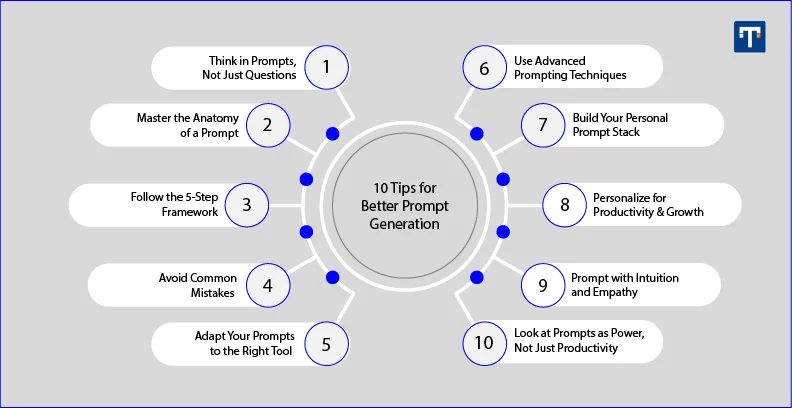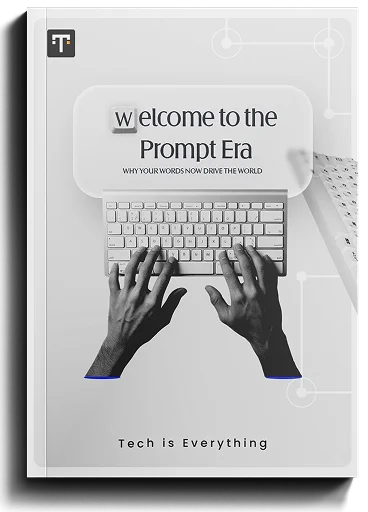Necessary Always Active
Necessary cookies are required to enable the basic features of this site, such as providing secure log-in or adjusting your consent preferences. These cookies do not store any personally identifiable data.
|
||||||
|
||||||
|
||||||
|

In today’s AI-driven world, prompts have become the new interface, replacing buttons, menus, and even traditional programming in many cases. Instead of writing complex code or clicking through software, users now communicate with AI using natural language, often with the help of an AI prompt generator that simplifies and enhances this process. This shift makes prompting a keyway to control and collaborate with intelligent systems.
As a result, prompt engineering, the skill of crafting clear and effective prompts, has quickly evolved into mainstream professional skills. It’s no longer just for developers or researchers. Marketers, designers, students, and business leaders are all learning how to write better prompts to get the best results from tools like ChatGPT, Claude, Gemini, and other generative AI models.
To be successful in this new interface, users need to apply structured thinking and define clear objectives. Just like writing good code, writing good prompts requires clarity, logic, and a deep understanding of both the tool and the task. In short, language has become the new code, and prompting is the skill that unlocks the full potential of AI.
In the world of artificial intelligence, knowing how to talk to AI is quickly becoming as important as knowing how to use a computer. Whether you’re using chatbots, generative AI tools, or large language models like ChatGPT, your ability to communicate effectively with these systems can completely change the quality of your results. This is where AI communication comes in, learning how to give the right instructions, ask the right questions, and guide the system toward the output you need.

This prompt engineering guide offers a tactical approach to building strong prompting skills. It’s not just about typing a sentence, it’s about understanding how the AI thinks, how it interprets context, and how to shape your input for the best possible outcome. From setting the right tone to specifying format, structure, or even personality, this guide will help you gain full control over your interactions with AI tools. As technology evolves, mastering AI communication is a must-have skill for anyone working in tech, business, education, or creative industries.
When using AI tools like ChatGPT, shift your mindset from simply asking questions to designing prompts with intent. Unlike a search engine, AI works best when you clearly define the outcome you want, whether that’s an explanation, a list, a story, or a strategy. Instead of typing “What is blockchain?”, try prompting, “Explain blockchain to a beginner with simple examples and avoid technical jargon.” This way, you’re giving the AI context, tone, and purpose, helping it generates more precise and creative outputs.
Think of AI as a collaborative partner, not just a command-line tool; it needs direction to deliver its best.
A well-crafted AI prompt isn’t random; it’s structured like a clear set of directions. The three essential elements are:
You can take it further by adding Parameters (like word count or tone), Constraints (what to avoid), and Evaluation Criteria (what defines a good response). Think of your prompt writing a creative brief for a teammate; it should guide, not guess. The more clarity you give, the better the AI performs.
Example: “Write a 150-word summary of this marketing memo in a conversational tone, avoiding technical jargon, and suitable for a time-strapped executive.”
CTA Line with Lead Magnet: Start building your prompts with intention by structuring is your superpower
Creating the best AI prompts isn’t guesswork; it’s a repeatable process. This structured approach helps transform vague inputs into precise, high-quality results. Use this 5-step framework to boost clarity and control:
Even the smartest AI can deliver poor results if your prompt engineering technique has gaps. Many users make simple mistakes that reduce the quality, clarity, and creativity of the output. These are easy to fix once you know what to look for. Here are the most common pitfalls to avoid when working with generative AI tools:
A key part of effective AI communication is knowing that one size doesn’t fit all. Different AI models are designed for different use cases, and using the same prompt across tools may not deliver the best results. To get the most out of your AI experience, you need to align your prompt with the tool’s core strength. Here’s how to do that:
Once you’ve mastered the basics, it’s time to level up with writing advanced prompt generating methods that give you more control, accuracy, and depth in your AI outputs. These techniques are especially useful for complex tasks, creative generation, or decision-making scenarios. By choosing the right approach, you can guide the AI to think more clearly, avoid common mistakes, and generate results that are tailored to your specific needs.
Just like designers use component libraries or coders rely on snippet banks, power users of AI should build a prompt stack, personalized toolkit of proven prompts, templates, and techniques. Over time, this helps you work faster, stay consistent, and get better results across different tools and tasks. A well-organized prompt stack saves time, boosts creativity, and gives you an edge in any AI-driven workflow. Using an AI prompt generator alongside your stack makes it easier to test, refine, and discover the best AI prompts for any situation.
Prompting isn’t just for tech or content work; it’s a practical skill that can enhance every part of your daily life. When used intentionally, AI becomes a smart assistant that helps you think better, work faster, and stay organized. From career growth to personal habits, a well-written prompt can turn a vague idea into a clear, actionable outcome.
Great prompting is more than just giving instructions; it’s about knowing how to connect with AI in a smart, human way. The best prompt writers develop something called digital intuition, an instinct for how AI understands language, tone, nuance, and ambiguity. They don’t just tell the AI what to do, they guide it thoughtfully, using clear, empathetic, and curious language. This means balancing structure (so the AI knows what’s expected) with creativity (so there’s room for fresh ideas).
Just like working with a teammate, great prompts use emotional intelligence; they consider the audience, the goal, and the best way to communicate.
Prompts are more than shortcuts for getting work done; they are powerful tools that shape how AI interacts with the world. A single prompt can influence how a student learns, how a brand connects with its audience, or how information is framed in sensitive situations. Whether you’re using AI to educate, advise, design, or communicate, your prompts carry the power to guide outcomes in ways that are human-centered, inclusive, and responsible. It’s not just about productivity, it’s about using prompting to build ethical, empathetic, and impactful technology.
Prompting isn’t just a skill; it’s becoming the language of collaboration between people and intelligent machines. As this interaction deepens, prompting will become a key driver of culturally sensitive, emotionally intelligent, and inclusive communication. It will help ensure that AI responds appropriately to diverse audiences, global contexts, and ethical challenges.
As AI becomes more advanced, prompting is no longer just about giving instructions; it’s about designing a two-way dialogue between humans and machines. The future of prompting is co-creative and conversational, where users and AI systems work together like collaborators. Instead of static commands, prompts will evolve into context-aware, adaptive conversations that respond to tone, emotion, and changing needs in real time.
The better you become at crafting prompts, whether through an AI prompt generator, structured prompt engineering, the more you’ll unlock AI’s true potential and not just for faster results, but for deeper thinking, sharper creativity, and smarter collaboration.
Download our free digital magazine packed with expert insights, prompt templates, and real-world use cases to take your AI skills to the next level.

Sign up to receive our newsletter featuring the latest tech trends, in-depth articles, and exclusive insights. Stay ahead of the curve!